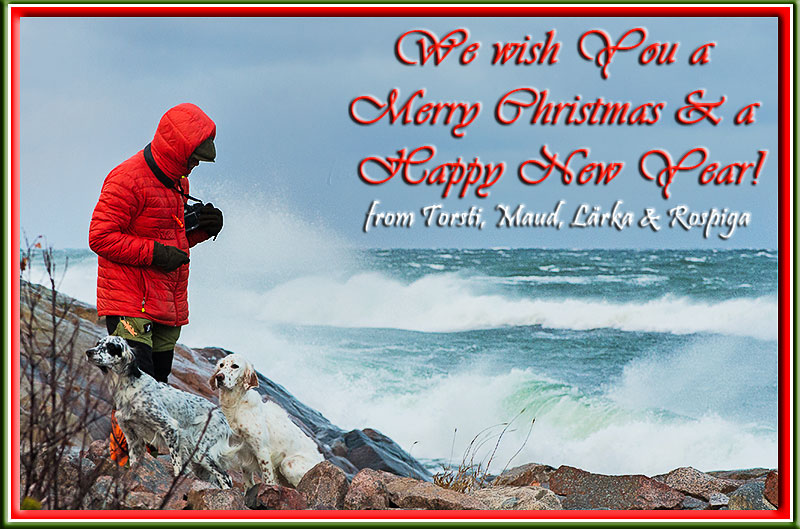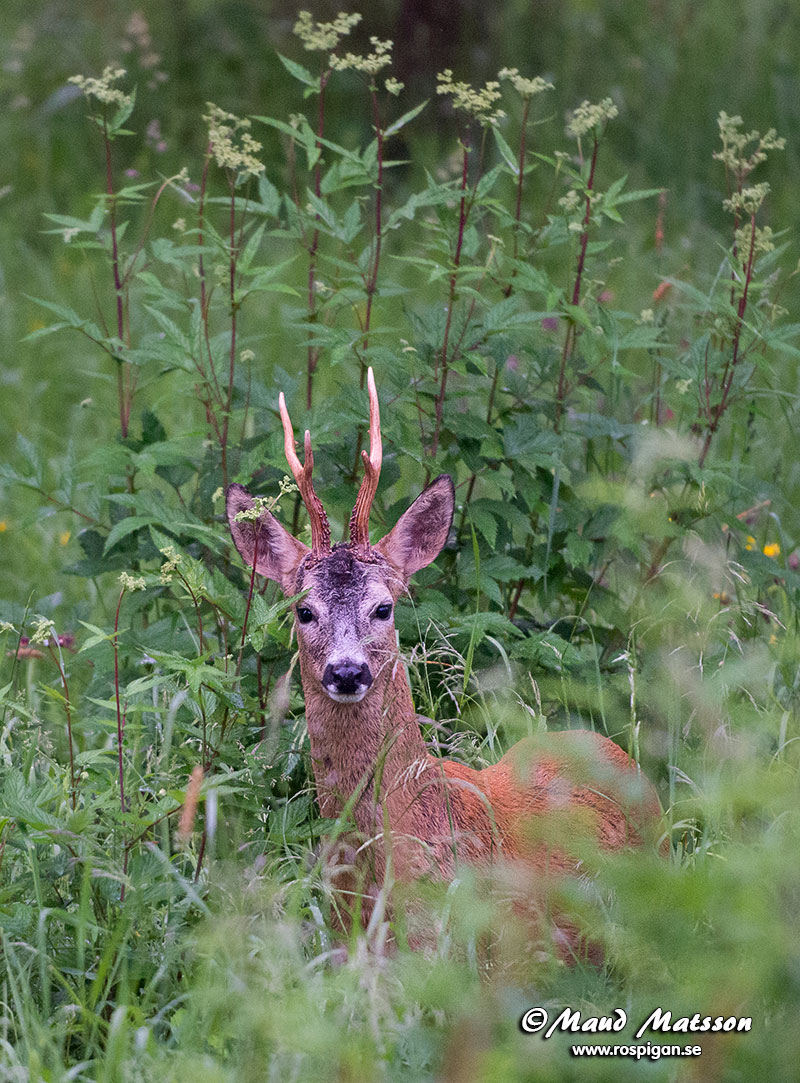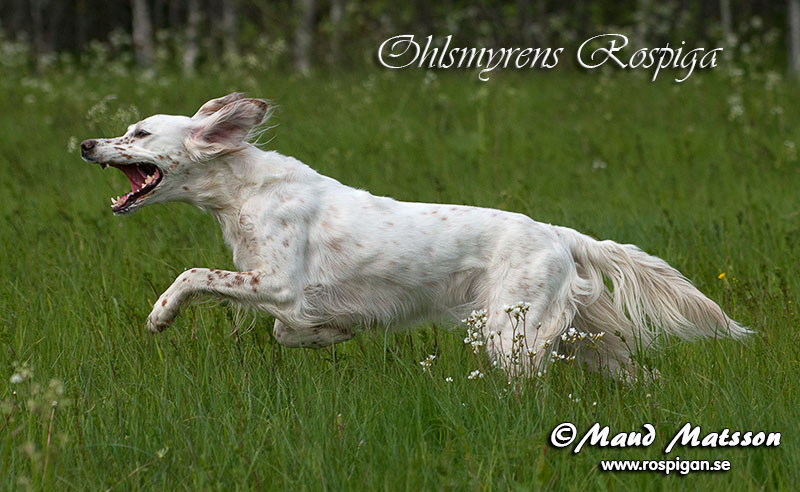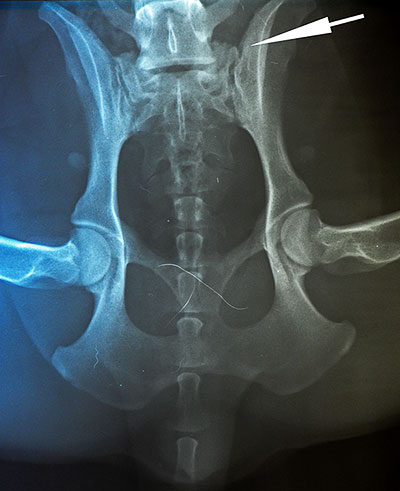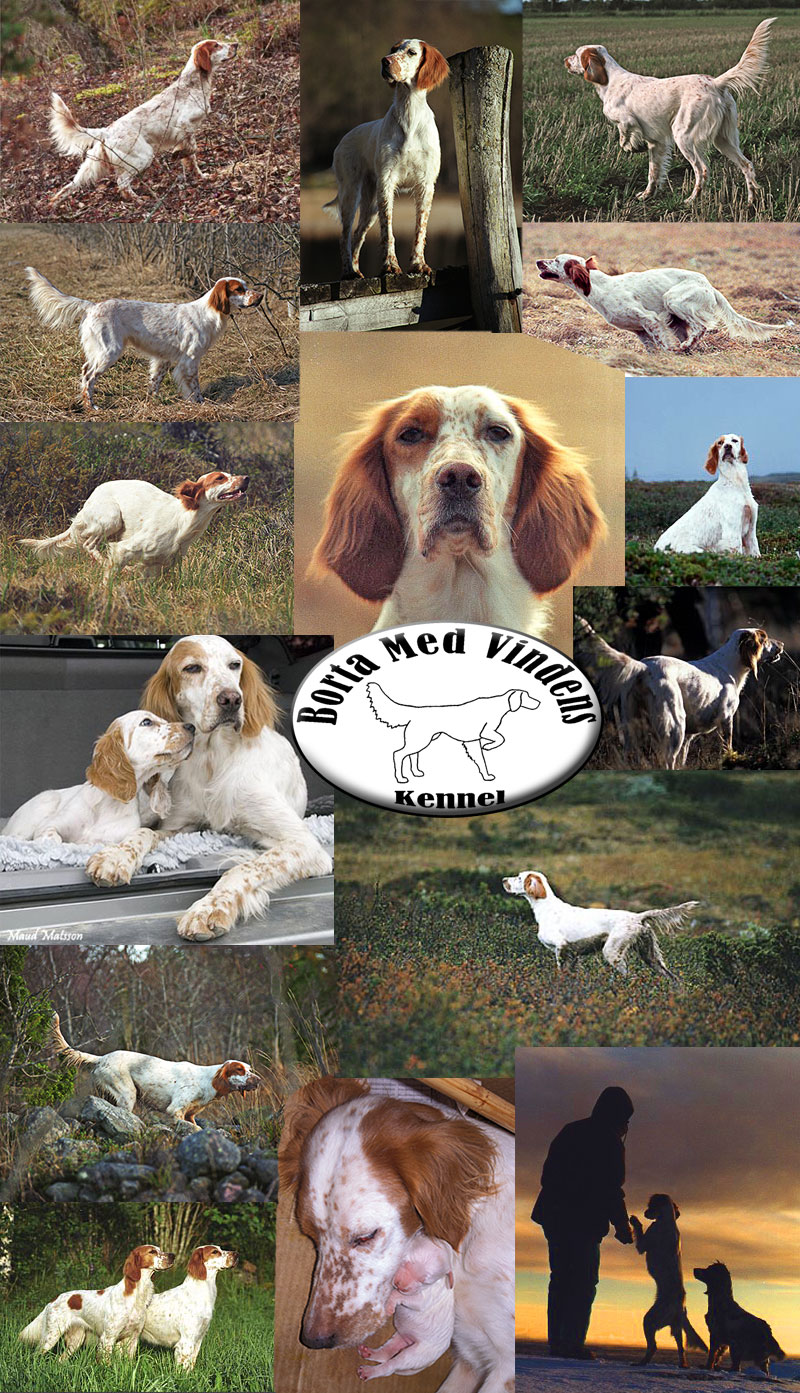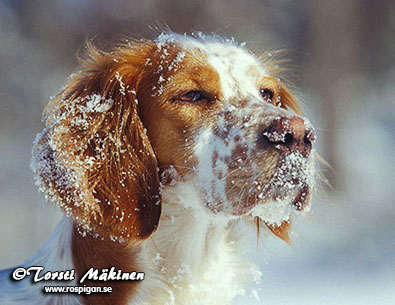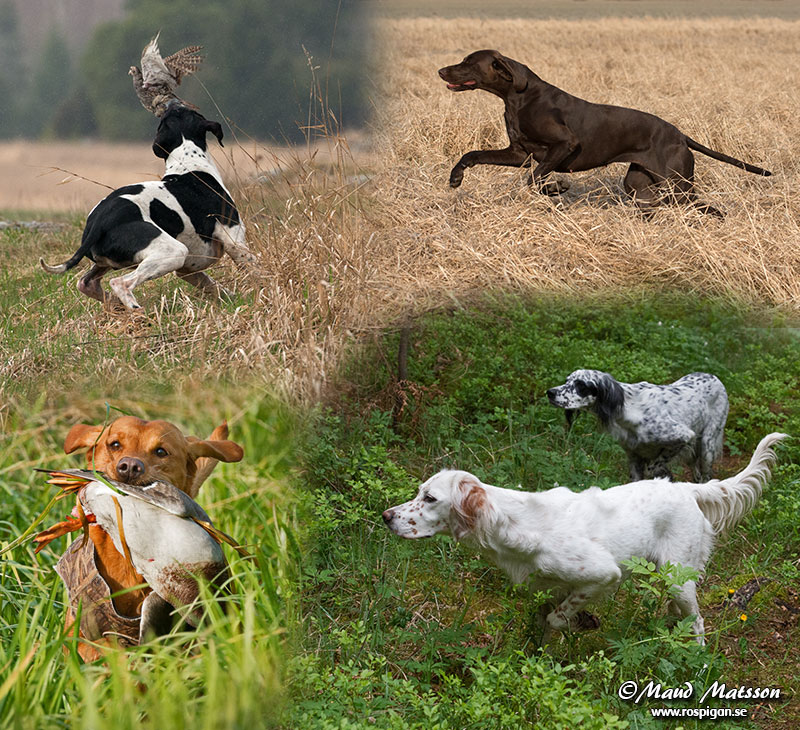Some truths and tales and Christmas greetings
This year’s Christmas photo has been taken at a somewhat unusual place for Christmas photos. It might have been appropriate had I still been an active sailor. “Maud and the dogs are anxiously waiting for me to come home for Christmas from the stormy sea!” However, I am now retired from the sea. Instead this is just another storm on the Sea of Åland, not far from our house, and I took this photo without risking my life, let be that I had to crawl on the icy rocks to get into a good position. The wind force was considerable, up to and occasionally over 30 m/s. Even the dogs found the conditions a bit inconvenient.
The wailing of a little sparrow over a pile of frozen horse manure The heading may sound odd to some of you, as it perhaps does even to some of us Swedish speaking folks. Well, it is this way: Rural sparrows often find some undigested seeds in horse manure. In the winter when they desperately need all the food they can get, the manure is frozen and they cannot get to the seeds. The wailing of the diminutive sparrow could mirror the common man’s disappointments when facing circumstances that he has no power whatsoever over. Here is my sparrow-wailing: Some 20 – 30 years ago the Swedish parliament, torched in the rear end by the EU and all sorts of the greenies and NGO:s, took the decision to reintroduce and spread large predators all over the country. The decision and the work to reintroduce them have definitely paid of now. On the land that I hunt the game has disappeared more dramatically than one may possibly expect during the last 3 decades. Of course I do not blame the predators for all the loss since change in agriculture, forestry and increased human activities of many different kinds also take their toll. Hazel grouse, Black grouse and Capercailzie are in all essence totally gone. Reduction in moose population is maybe 80 - 90% (too many licenses given). Reduction in roe-deer population: 90% or more is gone (predation by lynx). Hare population: 90% or more has vanished (predation by lynx). Fox population is a shadow of what it was; do not know why… do lynx eat foxes also? Seafowl has since long been driven away by ever increasing leisure activities on the coastline and archipelago and leisure boat traffic on the sea. Sea eagles have increased really a lot and they take more seafowl than folks can imagine. Sea eagles alone can of course not destroy a sea fowl population but put them on top of everything else that disturbs the life of the arctic ducks….. Do not even remotely think about suggesting that I as a hunter have killed all of the game to extinction! If I had, I would be mighty proud because it would make me to an unequalled hunter….. and since I always eat what I kill I would also be an unequalled fat hunter! Well, do I have to say more? One more thing: I have done more than just whined over the misery. I have sent letters, real letters written on real paper, with what I consider as significant information about effective conservation to the minister of agriculture, the minister of environment and the Swedish Environmental Protection Agency and the Swedish Hunters Organization. None of them have even bothered to acknowledge my letters, lot less answered them. These are the sad facts and obviously it is not politically correct to discuss them. Facts have no place in politics but politics are forced upon us even when the facts and common sense are speaking against the politics. Do you see the point? “In a civilized and cultivated country wild animals only continue to exist at all when preserved by sportsmen. The excellent people who protest against all hunting, and consider sportsmen as enemies of wildlife, are ignorant of the fact that in reality the genuine sportsman is by all odds the most important factor in keeping larger and more valuable wild creatures from total extermination.” - Theodore Roosevelt
The “Piriformis syndrome” “M. piriformis arises from the pedicles of the second and fourth sacral vertebrae. M. piriformis passes the greater foramina, courses laterally and inserts the superior border of the greater trochanter”. This is a scientific account of a tiny, indiscrete muscle in our pelvis. In addition it is in contact with N. ischiaticus at a place. When the piriformis muscle gets inflamed or cramps or goes into whatever abnormal condition, it can irritate the ischiaticus nerve and causes a pain that sometimes can be very vague and very difficult to diagnose. I have had this syndrome several years ago and can occasionally feel it even today. I cure it with some special stretching and often it is no big deal to cure once it has been properly diagnosed.
Hard working gundogs, like our Rospiga above, now and then gets different kinds of injuries in their muscles, tendons, ligaments and other tissues. There are close points of similarity to elite athletes in that respect. Another close point of similarities is that these dedicated gundogs and elite athlets can and will if needed continue to work like nothing had happened despite of considerable pain. Both of them have the same winning mentality that drives them on and on.
Rospiga started to limb with her left rear leg after hard work early in the autumn. Then she wanted to be lifted into my pick-up, from having literally “flown” into it before. When we stretched her rear legs and compared the width of the movements with Lärka´s we saw that Rospiga´s were restricted. That and some other signs of discomfort in her rear end convinced us to take her to an orthopaedist vet. He made a palpation and x-rayed her pelvis and hips without being able to pin-point the cause of the pain, so he sent us to an animal hospital. They were equally unable to diagnose positively. Instead Rospiga got a prescription of anti-inflammatory medicine and an order to avoid any hard activity for two months. In addition it was discussed if it was wise to breed on Rospiga? The conclusion was that a pregnancy would loosen up her pelvis and possibly make her even more vulnerable to future injuries. So it was decided that no litters were to be taken from Rospiga……… This is of course a sad decision but the most important thing is quite naturally that Rospiga gets well now and stays well in the future. Even though Rospiga was very much liked by everyone who saw her on the field, and the planned litter was fully booked already, there is this fact that there is no lack of good English setters in Scandinavia and hence there is no point, nor any sense in risking Rospiga´s health. As I write this in the beginning of December -16 she has already recovered rather well. Should she, when again started on the field, once again show signs of injuries, we have found that we live only around a two – three hour drive from the most competent Swedish orthopaedist veterinary clinic. During these weeks I started to think, since it was so difficult to get a positive diagnose, if this piriformis syndrome that I described in the beginning of this chapter, also hits dogs? Is the pelvis in a dog so similar to a human pelvis so it would be possible? I had no idea but due to a lucky coincidence we had an acquaintance that resides in Denmark to study to a veterinary surgeon. She quickly found a case report written by a Dr. Vet. Med. Maja Guldborg in Denmark discussing the syndrome in dogs and describing the successful treatment of a 3 year old Labrador retriever once the difficult diagnoses had been made. Of course I do not have the faintest idea of whether Rospiga has this problem. The interesting thing here is that I learned how similar the anatomy of dogs and humans in fact are - as I earlier have learned are also their mentality and way of thinking. The other good thing is that we now have at least learned to know about the existence of this rare problem in dogs. Hence, should Rospiga´s problems again arise in this vague form; it could be used as a last straw of hope to cure her.
The Kennel that doesn’t produce dogs!
J SUCh Lp1 Skedoms Foxy, as presented in the photo collection above, has so far been the only bitch we have bred from in our kennel. Had we had the sense to choose more suitable Sir´s she could have started a line of "our" own setters. However, when chance has a say, as it now and then has, things do not always turn out as planned......
Our kennel “Borta med Vinden” (Gone with the Wind) is now 18 years old. The name came quite naturally when we at the end of 1990:s had learned the most significant traits of our ES bitch Skedoms Foxy and her search width. Her search was very wide and extremely enduring! When she was let free on wide fields or on bare mountain she was, at least in our less experienced eyes, like swept away by the wind! However, veteran field triallers and mountain combers of the old school liked her a lot and we decided to use her as the start of a future strain.
So we had two litters from her but soon it was proved that the Sir´s we used, although they were good birddogs, were too soft in mentality to suit Foxys irrepressible hunters-head of an Indian warrior. The litters were very uneven and the bitch pup Briz from the second litter that stayed with us was a rather ticklish character. Once we had learned to co-operate with her she, after all, developed into the best gundog we have had, and in the end I gave her the title PH= Professional Hunter. However, that did not mean she was suited to be bred from – for the simple reason that the traits of the outcome would be too difficult to predict and moreover: What kind of a Sir would be most likely to suit her special character? One of the other puppies from the two litters became a FTCH and all of them became satisfactory or good gundogs and family members. More than one of them had Sweden’s highest society shooting over them so even if they perhaps were not exactly Ferraris they at least held good or high Volvo class. Still, we had nothing to breed from… As amateurs we had, and still have, a high goal with our breeding and that is to produce dogs that are better workers than the average for the breed. The beloved but unfortunate Sunnie would have been a perfect breeding bitch in every respect, but she had to leave us far, far too soon. Rospiga was our latest hope but the way things look now she will never have a litter.
So what about Lärka? She has the lean and light body and the speed and style and the endurance of a birddog. She has all the game finding ability and the prey drive one can ask for in a setter. Then again; although she is also a really nice family dog she transforms, like The Incredible Hulk, into a hard-headed, incurable self-hunter as she picks up speed on the hunting grounds, and she has always been that way. Instead, and do not ask me to explain why, it would take too long time, I think really seriously that she would be as excellent as a lead-dog for a moose or deer hunter as she is difficult for the bird shooter! Springer the Spaniel, wasn´t she a really good working spaniel and wasn´t there folks who asked for her progeny? Yes, but she had the tendency to wind up in stress and stress in a dog is very difficult to control. Hence she was not suited to breed from. These are some of many possible things that can happen to a breeder of dogs and a more professional kennel of course will compensate for the unexpected by having a lot of dogs of good quality. We cannot do that. Two or three dogs are within the comfort zone for us, and it must stay that way to keep both us and the dogs happy. If none of them are suited to breed from, for whatever reason, then it simply cannot be. So there we are with this kennel that doesn´t produce dogs!
Some words of wisdom from the late Clement Walton We have used Clements knowledge and ideas about dog training and their handling on many places in our website. Here is a longer working-gundog forum input from him dated April 2002. It is in my opinion worthy reading for deeper consideration during the peace of the Christmas holidays. There is some serious truth hidden in the text, particularly valuable for the beginner with gundogs.
All training of hunting dogs is more or less the development of an interactive relationship between a person and a dog. The training is more or less a collective term representing the way that the interactive relationship develops. The relationships between people and their dogs constitute an extraordinarily diverse range of interactions from total control by the human to total dominance by the dog. We all wind up somewhere in this array and our final result isn't fixed, it's a variable and the consideration at issue for us is how we get to that interactive relationship For those who want total control, let us call them the retriever people, the driving force in the relationship is primarily human, for those who don't want to interfere with the dog, let us call them the field trial pointer people, the driving force in the relationship is the inherent abilities and characteristics of the dogs themselves. The question of course becomes one of the desired relationships, do you want it to be 75% you and 25% the dog or do you want it to be 75% dog and 25% you? The methods you choose for training and the objectives of your training determine the nature of the relationship. We don't appreciate it at first but there is an enormous element of random chance in your view of the ultimate relationship between you and a dog... everything depends on those you happen to encounter when you start thinking about training a dog and those who influence you during that development. In short what you want from a dog is determined by your personal experience. The development of training systems (for want of a better descriptive term) tends to create an uneven distribution of control relationships. Retriever people want 100% control of a dog with drive, the versatile (olika kontinentala hundar av "mångsidig" vorsteh-typ etc.) people want 100% control of a dog with drive but have to accept that the dog will not hunt properly without independence and so accept shared control of the teamwork with the dog. The field trial pointer people want an all-out performing dog that isn't hampered by a lot of interactive stuff with a human, for them the teamwork performance is 90% dog and 10% handler, And there are all stages in between these clustered groups. The relationship between you and your dog, that is which of you has what percentage of control of the relationship, is determined by the way you choose to go about training the dog. Those who choose to train with force and want to dominate the team relationship do well with some prescribed training regimens. Those who choose different methods of forcing achieve a different relationship with the dog. Each person who trains has to accept that there will be something that they're not going to get from their dog, consequences of the training methods that they will accept as an expected limitation of the game that they play. If you have absolute control of the dog all of the time that you work as a team you aren't going to get great bird finding and handling ability from the dog but the retrieving is going to be consistent. If you give the dog enough latitude to hunt very productively you have to accept that you cannot control the dog as much as you might prefer, or as the books say that you should. If you stop interfering with the dog's hunting completely and don't want to take the chance that a lot of training routine will dampen the dog's enthusiasm and spirit you can get a hell of a bird finding machine that may prove to be a sloppy or indifferent retriever. I think that the message I have to offer is that you can get anything you want from a relationship with your dog and the methods you use in your training will produce certain results and also result in certain disadvantages. Those with the training problems are, of course, those who choose a method of training that leads to dog/human interaction that they do not want. We can describe methods to force everything to a controlled performance... we can describe methods that will lead to interactive operation of a dog/human hunting team or we can show you methods that will not dampen the dog's drive or enthusiasm. None of these are correct or incorrect, the only important ting for the trainer to understand is that you will get the dog that you have earned and, if you're lucky, it's the dog that you wanted. The value of this list is, of course, that we can collectively help any participant to get more or less what they want from their dog but we should also explain what you have to give up in order to get what you want. I would hope that whatever you want we could find some way for you to get there. We can bring this Christmas tale to a close with Clement Walton’s humble words: "It has taken me a long time to understand that every wonderful thing I have Happy Holidays!
©Text: Torsti Mäkinen. ©Photo: Torsti Mäkinen & Maud Matsson. www.rospigan.se |
